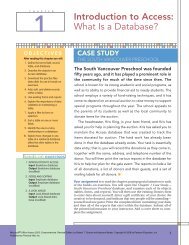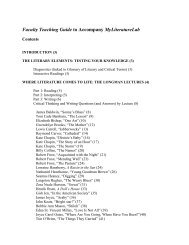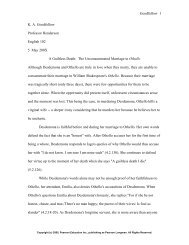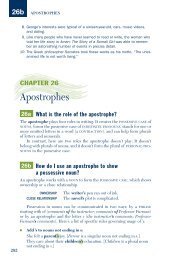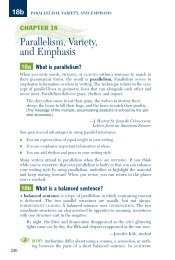chapter 3 - Pearson Learning Solutions
chapter 3 - Pearson Learning Solutions
chapter 3 - Pearson Learning Solutions
Create successful ePaper yourself
Turn your PDF publications into a flip-book with our unique Google optimized e-Paper software.
2009934667<br />
Chapter 3 Nonverbal Communication 57<br />
o you believe that when you communicate with another person, your<br />
words carry the majority of the meaning of the message? If you<br />
answered yes, you are mistaken. There has long been an awareness that<br />
it is possible to communicate a great deal even without using verbal<br />
language. We also are aware that nonverbal acts are symbolic acts closely connected<br />
to any talk in progress. They don’t merely reveal information; they represent meaning.<br />
1 “Nonverbal communication is a major force in our lives.” 2 Nonverbal behaviors<br />
such as smiling, crying, pointing, caressing, and staring appear to be used and<br />
understood the world over. 3<br />
Nonverbal communication is composed of “all those messages that people<br />
exchange beyond the words themselves.” 4 We have interpreted body talk, perhaps<br />
without knowing we were doing so, but only in recent years have attempts been<br />
made to analyze and explain nonverbal communication in a scientific manner.<br />
Research has established that nonverbal language is an important means of<br />
expression. Experts in the field have identified patterns of body language usage<br />
through the study of films and videotapes and through direct observation.<br />
Nonverbal acts seem to have three key characteristics: they are sensitive to the<br />
relationship between the sender and receiver; they have meaning based on their<br />
context (the communicators, the setting, and the purpose of the communication);<br />
and they are part of, not a separate entity from, verbal communication. 5<br />
D<br />
Because the study of nonverbal communication is more recent than the study<br />
of verbal communication, we do not yet have a dictionary of its terms or a thorough<br />
understanding of the process involved. But attempts are underway to apply the<br />
information that has been collected. One such attempt, known as neurolinguistic<br />
programming, has been developed to codify and synthesize research on nonverbal<br />
communication with that of other fields of communication, including cybernetics<br />
(the study of how the human brain processes information) and language study.<br />
Traditionally, experts tend to agree that nonverbal communication itself<br />
carries the impact of a message. “The figure most cited to support this claim is<br />
Communicating: A Social and Career Focus, Tenth Edition, by Roy M. Berko, Andrew D. Wolvin, and Darlyn R. Wolvin. Published by Allyn & Bacon.<br />
Copyright © 2007 by <strong>Pearson</strong> Education, Inc.<br />
Few of us realize how much<br />
we depend on nonverbal<br />
communication to encourage<br />
and discourage conversations<br />
and transactions.






